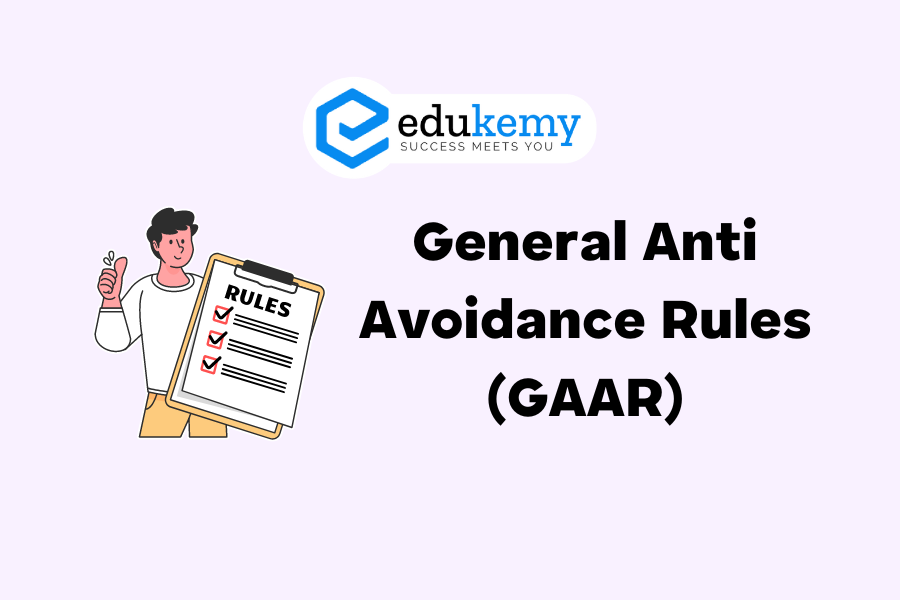
General Anti Avoidance Rules (GAAR) are regulatory measures designed by governments to combat tax avoidance strategies employed by individuals and entities. GAAR aims to prevent taxpayers from exploiting legal loopholes or engaging in transactions solely for the purpose of reducing their tax liabilities. By empowering tax authorities with broader discretion to scrutinize and challenge arrangements deemed abusive or artificial, GAAR serves as a deterrent against aggressive tax planning practices. Implemented in various forms across jurisdictions worldwide, GAAR represents a proactive approach to ensure fairness and integrity within the tax system, promoting compliance and equitable distribution of tax burdens.
Contents
General Anti Avoidance Rules (GAAR):
- Background:
- Some firms and individuals engage in practices to minimize or completely avoid tax payments, exploiting legal frameworks. Instances like the Vodafone-Hutch deal, where tax avoidance through offshore agreements raised concerns, prompted the government to address such practices.
- Doctrine of “Look Through” vs. “Look At”:
- In cases like Vodafone, the government applied the doctrine of “look through” instead of “look at.” This meant examining the substance of the transaction rather than its legal form. The government deemed the tax avoidance to be tax evasion, leading to a demand for clear rules.
- Introduction of GAAR:
- In response to the need for clarity and anti-tax avoidance measures, the Government of India introduced General Anti Avoidance Rules (GAAR). These rules were framed by the Department of Revenue under the Ministry of Finance.
- Operationalization and Objectives:
- GAAR became operational on April 1, 2017, with the primary objective of preventing tax evasion disguised as tax planning.
- Key Provisions of GAAR:
- Grandfathering Provision:
- Investments made until March 31, 2017, were not subjected to GAAR, providing a transition period.
- Threshold for Applicability:
- GAAR is applicable to those claiming tax benefits of over Rs 3 crore.
- Vetting Process:
- The application of GAAR undergoes a two-stage vetting process:
- First, it is vetted by the Principal Commissioner/Commissioner of Income Tax.
- Second, an Approving Panel, headed by a high court judge, reviews the proposal.
- The application of GAAR undergoes a two-stage vetting process:
- Procedural Safeguards:
- Adequate procedural safeguards are in place to ensure that GAAR is invoked uniformly, fairly, and rationally.
- Grandfathering Provision:
- Objectives and Impact:
- The rules are designed to enhance transparency in tax matters and curb tax evasion by preventing transactions lacking a genuine commercial purpose other than tax avoidance.
GAAR serves as a tool to deter and penalize artificial arrangements aimed solely at tax evasion, contributing to the overall integrity of the tax system.
FAQs
1. What are General Anti Avoidance Rules (GAAR)?
- GAAR refers to a set of legal provisions aimed at preventing taxpayers from engaging in abusive tax avoidance practices. These rules empower tax authorities to disregard transactions or arrangements that are artificial or lack commercial substance.
2. How do GAAR work?
- GAAR allows tax authorities to look beyond the legal form of transactions and assess their true economic substance. If a transaction is deemed to be primarily motivated by tax avoidance rather than legitimate commercial reasons, tax authorities can deny the tax benefits associated with it.
3. What types of transactions are targeted by GAAR?
- GAAR primarily targets transactions that lack economic substance, involve misuse or abuse of legal provisions, or are structured in a way to unduly exploit tax laws. This can include complex schemes, artificial arrangements, or transactions solely designed to obtain tax benefits.
4. What is the objective of implementing GAAR?
- The primary objective of GAAR is to ensure that taxpayers pay their fair share of taxes by discouraging aggressive tax planning strategies aimed solely at minimizing tax liabilities. By deterring abusive tax avoidance practices, GAAR helps maintain tax fairness and revenue integrity.
5. What are the consequences of falling foul of GAAR?
- If a transaction is found to contravene GAAR, tax authorities can disregard or recharacterize it for tax purposes. This may result in the denial of tax benefits, imposition of additional tax liabilities, interest, and penalties. Additionally, reputational damage and legal consequences may arise from engaging in abusive tax avoidance schemes.
In case you still have your doubts, contact us on 9811333901.
For UPSC Prelims Resources, Click here
For Daily Updates and Study Material:
Join our Telegram Channel – Edukemy for IAS
- 1. Learn through Videos – here
- 2. Be Exam Ready by Practicing Daily MCQs – here
- 3. Daily Newsletter – Get all your Current Affairs Covered – here
- 4. Mains Answer Writing Practice – here

